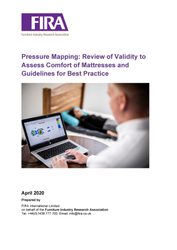

Mattress Specification Template
A resource to help mattress manufacturers develop detailed specification sheets or improve their existing ones

A suggested mattress evaluation method, offering practical guidance for manufacturers, designers and retailers when comparing the comfort of mattresses. It takes into consideration the test environment, selection of participants, positioning of subjects, the test duration and the analysis of data
The average person spends a total of 12,045 days, the equivalent of 33 years in bed. 7 years of this total is spent trying to get to sleep (Curtis, 2017). Getting the right amount of good quality sleep is critical to an individual’s overall health and wellbeing. There are multiple factors that affect the quality of sleep, one of which is the mattress being used. Since so much of a person’s life is spent in bed, the mattress could be the most important piece of furniture in the home. Sleeping on an appropriate mattress is an imperative component to receiving the quantity (Lee & Park, 2006) and quality of sleep we need to allow the body to rest and allow our mental and physical wellbeing to thrive. The suitability of a mattress not only affects the quality of sleep in the short term but can also impact spinal health in the long term, a mattress that supports the natural curvature of the spine can help to prevent the development of musculoskeletal problems.
As consumers have more and more choices of mattresses available in the marketplace, manufacturers are having to work harder to distinguish themselves and convince these consumers of the benefits of their brand over another. Likewise, consumers are faced with a difficult decision when trying to find the right mattress due to the vast array of options on offer.
Pressure mapping is one method which has been used in the mattress retail industry to help customers decide between products, however, little research has been undertaken to determine how pressure mapping can be used to best predict the effect of a mattress on short and long-term comfort and spinal health. The data output from pressure mapping equipment can also be manipulated in multiple different ways, this can be beneficial when carrying out research and product development, but it can also be used to mislead consumers in order to sell a specific product.
In order to help manufacturers with their product development, and consumers to have confidence in their mattress buying process, it is proposed that a standardised test be developed to assess how well a mattress will cater for the wide variety of different sizes and shapes of consumers that will use it.
The primary aim of this research project is to determine the most effective method of interpreting Interface Pressure Mapping (IPM) results, with a view to using this data to try to predict levels of ‘comfort’ and ‘discomfort’. This research project focuses on interpreting IPM results for mattresses; however, the results could be transferable to be applied to other products e.g. seating.
A further aim of this project is to highlight other methods that can be used in conjunction with IPM to help predict (dis)comfort levels and key factors that affect the validity of test results. The resulting information will be used to propose a standardised method of assessment to evaluate mattresses in a consistent and repeatable way. This will also provide practitioners and manufacturers clarity on the important factors to consider when evaluating mattresses.
The literature reviewed in this report was identified through a systematic literature review. The following keywords were used within the search: ‘pressure mapping’, ‘subjective’, ‘IPM measurements’, ‘objective’, ‘pressure distribution’, ‘spinal health’, ‘pressure distribution’, ‘comfort’, ‘sleep’ and ‘mattresses’. References of all of the selected papers were searched meticulously by screening titles as well as abstracts, where necessary. The breadth of the literature reviewed did not solely focus on mattresses but seating also, as whilst there is currently a gap in the knowledge and testing for mattress IPM readings and comfort, previous test method procedures for assessing pressure and comfort/discomfort in seating may be of use to inform the development of a standardised test method for mattresses.

Pressure Mapping: Review of Validity to Assess Comfort of Mattresses - Guidelines for Best Practice
Login to download

A resource to help mattress manufacturers develop detailed specification sheets or improve their existing ones

This FIRA Standard specifies the performance and dimensional requirements of bariatric beds. It covers test methods and requirements for the safety, strength and durability for use by persons weighing between 150 kg to 250 kg (23.5 – 40 stone)


A summary of the key restricted substances associated with the most common types of materials present in mattresses to help in the creation of product-specific Restricted Substances Lists (RSL) and the development of testing and compliance programmes